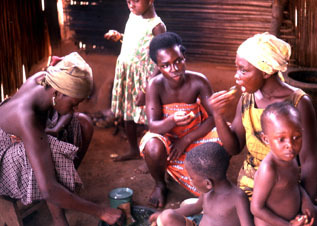Commence the Commensality!

Sarah Pink (2009) writes with emotion and humanness in her book Doing Sensory Ethnography. Her primary thesis is that to do ethnographic studies wisely, the ethnographer must be open to looking inside herself (reflexivity) as well as looking into the lives of others. Sensory Ethnography demands a commitment to hands-on research that dives beneath the surface of mere observation of one’s “informants” to a place where every part of the researcher – including all five (plus) senses – is involved in the search for “knowing.” Pink discusses both theory and practice and challenges her readers to break out of conventional research into a much more sensory method. She says, “…the notion of ethnography as a participatory practice is framed with ideas of learning as embodied, sensorial, and empathetic [italics mine], rather than occurring simply through a mix of participation and observation” (63). She further states, “Participation might be understood as producing multisensorial and emplaced ways of knowing whereby visual observation is not necessarily privileged. Given the centrality of experience to this methodology, ethnographic knowledge production is an essentially reflexive process” (63). In essence, then, the researcher is not merely observing that which can be seen, touched, heard, smelled, and tasted externally, but is intentionally conscious of what is occurring within herself. This is full sensory commitment to knowing and learning about “the other” and about oneself.
I had the great privilege of living and teaching in Egypt in 1990 and 1991. This was a tough time for me in many ways. As a student of intercultural studies, I thought I knew what I was doing. But when actually experiencing this culture face to face – its sights, its smells, its noise, its tastes, its beliefs, and its flies [that is one Egyptian plague that has not gone away] – I was made painfully aware of how much I had to learn. I began to realize that my preparation was far from adequate, but I also came to understand that it was I who had to turn theory into practice. So, I had to fight off depression and fear and go out to be among the people, inadequate as I was. What I learned through this participatory-style ethnographic research, was that I was the learner as I ate, talked, worshipped, and walked with Egyptians. I made countless mistakes along the way (particularly with my infant Arabic), but this began my journey of sensory ethnography. There is one particular experience that I will never forget that had to do with applied commensality, defined by Seremetakis (1994) “as the exchange of sensory memories and emotions, and of substances and objects incarnating remembrance and feeling” (Pink, 2009, 73).
We were invited to have lunch in the home of a family in our church in Upper Egypt one Sunday, so we (my wife and two children) walked with them to their home. It was probably around 11:30 AM. After we arrived, we were served tea and sat in the sitting room chatting for an hour in English and Arabic. Then one of the family members said that he needed to go out to buy some fish for our lunch. At that point, our hosts handed us “galabeyas” (a type of Egyptian night gown) and led us to their bedroom where they bid us to take a rest before eating. A couple hours later we dined together for well over an hour, eating, drinking, talking, laughing. We then went into the sitting room to talk some more for at least two or three hours. Then we were bidden to take another rest and eat another meal with them. We then talked more and drank more tea. We finally left around midnight after many hugs and kisses and walked to our flat with sleeping kids, arriving home around 12:30 AM. “Please come for lunch” took on an entire new meaning to us after that day. We had learned that Egyptian hospitality had a much different definition than American hospitality. We were involved with this family’s lives for a good 12 hours. So who learned about culture that day? We all did. This is sensory ethnography and its finest, and to this day I return to that apartment in my mind every time I eat fish. I wonder what they remember?
Before leaving for London, I will be meeting with a group of academic advisors/mentors who are journeying with me through the LGP program. They give great input and keep me accountable to my academic and personal goals. They are all great men; I am blessed to have them in my life. We will meet at a unique place where we will commune together over the next three years – at a local British pub. So why do we meet here? For commensality, of course! For all cohort members and soon-to-be London sensory ethnographers — let the comensalitation begin!
________________________________________________________________
Pink, Sarah. Doing Sensory Ethnography. London: Sage Publications, 2009
Serametakis, L., 1994. “The Memory of the Senses: Historical Perception, Commensal Exchange, and Modernity,” in Taylor, L., (ed.), “Visualizing Theory.” London, Sage. Quoted in Sarah Pink, Doing Sensory Ethnography (London: Sage Publications, 2009).
Leave a Reply
You must be logged in to post a comment.